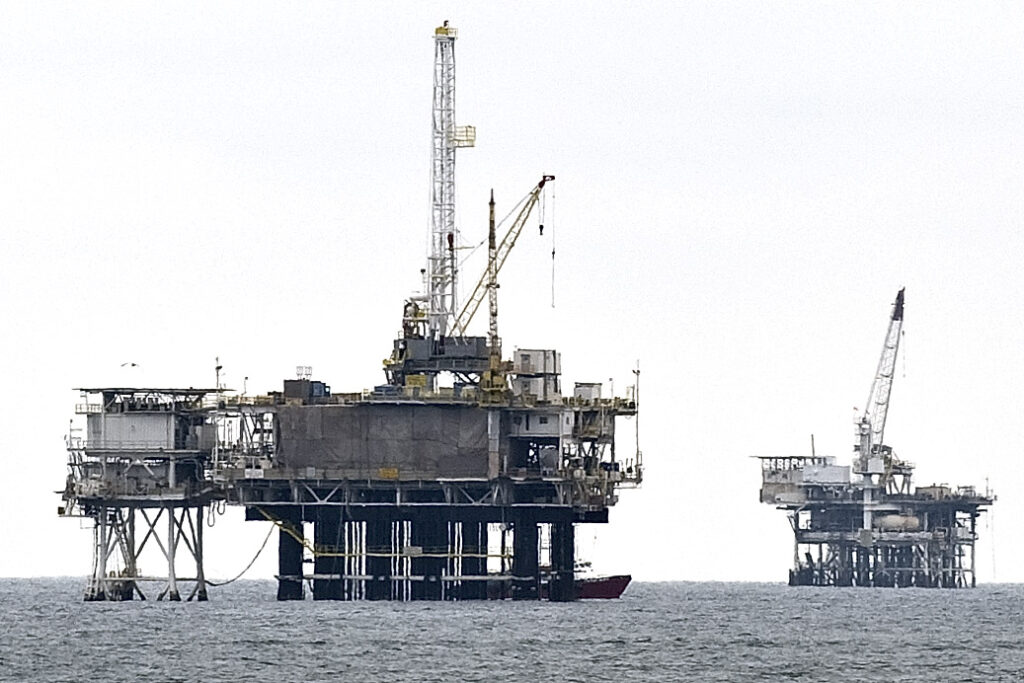
A bill aimed at ending offshore oil drilling in state waters calls for officials to negotiate with companies that own the leasing rights to the last three of those platforms, all off the coast of Orange County.
State Sen. Dave Min, D-Irvine, said the goal of his bill, SB 559, is a quick and fair end to the local risk of “economic and environmental catastrophe” that comes with offshore drilling. Without the negotiated settlements his bill proposes, the platforms could legally keep operating until they run dry, possibly after several decades.
“Each oil spill has massive impacts that not only result in direct costs to the state, such as for cleaning our beaches, but indirect costs from the damage to our coastal economy,” Min said in an interview and via email.
“To the extent that ending offshore drilling eliminates the risk of oil spills from those platforms, that is a massive net savings for California residents.”
Min pitched a similar idea a year ago, months after an October 2021 oil spill off the coast of Huntington Beach that closed beaches in Orange and San Diego counties, fouled estuaries and hurt everybody from swimmers and homeowners to big hotel operators and local commercial fishermen.
But Min’s plan died last year after the state Assembly passed a separate but potentially related proposal, to have the California Lands Bureau study how much oil operations have cost the state. Now, with the state armed with some of that information (the study is expected to be concluded by the end of next year) Min believes the Lands Bureau will be better equipped to negotiate decommissioning deals favorable to taxpayers.
Still, cost will be key. Based on the amounts spent to close down other offshore oil operations, the cost of shutting the three platforms off the coast of Orange County – known as platforms Eva, Emmy and Ester – would run between $1 billion and $2 billion. How much of that would be paid by oil companies, and how much by taxpayers, would be the subject of negotiations and, perhaps, a source of controversy in blue-leaning California. The state also is facing a projected budget deficit of more than $20 billion.
“It’s a fantastic bill, except we feel strongly that polluters should pay all of the costs associated with closing those operations,” said Brady Bradshaw, senior oceans campaigner for the Center for Biological Diversity, a nonprofit conservation group.
Min said his plan takes that into account. The bill, he wrote, “nets out the expected revenues from these offshore leases against the costs of decommissioning the platforms and wells, which gives us a true market value rather than the ‘heads I win, tails you lose’ approach that oil companies benefit from now.”
By law, offshore drillers in California are required to pay for the costs of decommissioning their platforms, but only after the wells are no longer productive. And the state definition of “productive” is loose, allowing oil operators to keep drilling for a tiny amount of oil each year as a way to stave off the massive costs of closing down an offshore plant.
State data shows that the oil operations off the coast of Orange County remain viable, if not big producers. Combined, several dozen wells connected with the three local platforms produced about 1.6 million barrels of oil during the fiscal year 2020-21, a tiny sliver of the total U.S. production of 4.1 billion barrels during that same period. The data also shows the local leaseholders paid the state about $18.3 million in royalties, and combined rent of about $20,000.
Min suggested his bill would compensate oil companies for ending those drilling rights early – “their leases have value,” he said – without letting them off the hook for the long-term costs of removing drilling operations.
Though details of SB 559 aren’t fleshed out, the proposal last year called for the Lands Commission to study the long-term value of those leases and estimated revenue, and then balance those estimates against the estimated costs of capping wells, hauling away equipment and possibly paying for environmental damages.
Another financial issue is the cost of any future oil spill.
In the year since Min last pitched this idea, companies connected to the Huntington Beach spill have been ordered to pay about $95 million in damages to Orange County fishing operators, tourism companies and homeowners, among others. But that spill was small, at just 25,000 gallons, and the money set aside for individuals and businesses doesn’t include clean-up costs or costs connected to long-term environmental damage and harm done to the county’s reputation for being next to a clean ocean.
Still, the example that might determine the fate of SB 559 is the payout underway related to Platform Holly, an oil operation off the coast of Santa Barbara. Until it ceased production in 2017, Holly was the fourth well in state waters.
That deal still frustrates Bradshaw and other environmentalists. The company that held the leasing rights for Holly, Venoco, filed for bankruptcy and ceased operations when that well was no longer productive, a move that shifted some decommissioning costs to California taxpayers.
Since then, the Lands Commission worked with the original operator of Holly, Exxon Mobil, to get paid for decommissioning the platform. As of last year, Exxon was expected to spend about $350 million and the state was on the hook for more than $130 million.
Min believes his bill would produce better results. But he also argued that any spending by taxpayers to compensate drillers for their future revenue would pale when compared to the economic and environmental cost of “the next spill.”
“This is a much better deal for taxpayers than the alternative,” Min said.
Related Articles
New deal in Huntington Beach oil spill boosts payout to locals to $95 million
